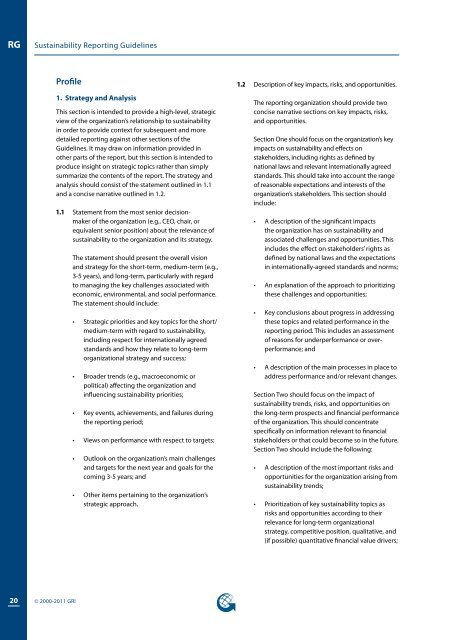G3.1 Sustainability Reporting Guidelines - Global Reporting Initiative
G3.1 Sustainability Reporting Guidelines - Global Reporting Initiative
G3.1 Sustainability Reporting Guidelines - Global Reporting Initiative
Create successful ePaper yourself
Turn your PDF publications into a flip-book with our unique Google optimized e-Paper software.
RG<br />
<strong>Sustainability</strong> <strong>Reporting</strong> <strong>Guidelines</strong><br />
Profile<br />
1. Strategy and Analysis<br />
This section is intended to provide a high-level, strategic<br />
view of the organization’s relationship to sustainability<br />
in order to provide context for subsequent and more<br />
detailed reporting against other sections of the<br />
<strong>Guidelines</strong>. It may draw on information provided in<br />
other parts of the report, but this section is intended to<br />
produce insight on strategic topics rather than simply<br />
summarize the contents of the report. The strategy and<br />
analysis should consist of the statement outlined in 1.1<br />
and a concise narrative outlined in 1.2.<br />
1.1 Statement from the most senior decisionmaker<br />
of the organization (e.g., CEO, chair, or<br />
equivalent senior position) about the relevance of<br />
sustainability to the organization and its strategy.<br />
The statement should present the overall vision<br />
and strategy for the short-term, medium-term (e.g.,<br />
3-5 years), and long-term, particularly with regard<br />
to managing the key challenges associated with<br />
economic, environmental, and social performance.<br />
The statement should include:<br />
• Strategic priorities and key topics for the short/<br />
medium-term with regard to sustainability,<br />
including respect for internationally agreed<br />
standards and how they relate to long-term<br />
organizational strategy and success;<br />
• Broader trends (e.g., macroeconomic or<br />
political) affecting the organization and<br />
influencing sustainability priorities;<br />
• Key events, achievements, and failures during<br />
the reporting period;<br />
• Views on performance with respect to targets;<br />
• Outlook on the organization’s main challenges<br />
and targets for the next year and goals for the<br />
coming 3-5 years; and<br />
• Other items pertaining to the organization’s<br />
strategic approach.<br />
1.2 Description of key impacts, risks, and opportunities.<br />
The reporting organization should provide two<br />
concise narrative sections on key impacts, risks,<br />
and opportunities.<br />
Section One should focus on the organization’s key<br />
impacts on sustainability and effects on<br />
stakeholders, including rights as defined by<br />
national laws and relevant internationally agreed<br />
standards. This should take into account the range<br />
of reasonable expectations and interests of the<br />
organization’s stakeholders. This section should<br />
include:<br />
• A description of the significant impacts<br />
the organization has on sustainability and<br />
associated challenges and opportunities. This<br />
includes the effect on stakeholders’ rights as<br />
defined by national laws and the expectations<br />
in internationally-agreed standards and norms;<br />
• An explanation of the approach to prioritizing<br />
these challenges and opportunities;<br />
• Key conclusions about progress in addressing<br />
these topics and related performance in the<br />
reporting period. This includes an assessment<br />
of reasons for underperformance or overperformance;<br />
and<br />
• A description of the main processes in place to<br />
address performance and/or relevant changes.<br />
Section Two should focus on the impact of<br />
sustainability trends, risks, and opportunities on<br />
the long-term prospects and financial performance<br />
of the organization. This should concentrate<br />
specifically on information relevant to financial<br />
stakeholders or that could become so in the future.<br />
Section Two should include the following:<br />
• A description of the most important risks and<br />
opportunities for the organization arising from<br />
sustainability trends;<br />
• Prioritization of key sustainability topics as<br />
risks and opportunities according to their<br />
relevance for long-term organizational<br />
strategy, competitive position, qualitative, and<br />
(if possible) quantitative financial value drivers;<br />
20<br />
© 2000-2011 GRI

















